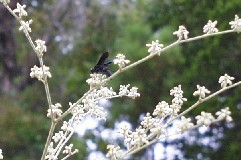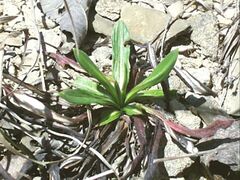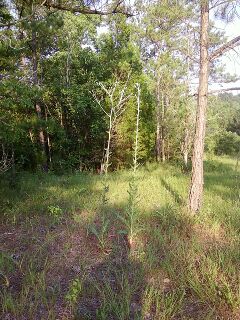Biology:Eriogonum longifolium var. harperi
| Eriogonum longifolium var. harperi | |
|---|---|

| |
| Scientific classification | |
| Kingdom: | Plantae |
| Clade: | Tracheophytes |
| Clade: | Angiosperms |
| Clade: | Eudicots |
| Order: | Caryophyllales |
| Family: | Polygonaceae |
| Genus: | Eriogonum |
| Species: | |
| Variety: | E. l. var. harperi
|
| Trinomial name | |
| Eriogonum longifolium var. harperi (Goodman) Reveal
| |
Eriogonum longifolium var. harperi, also known as Harper's buckwheat or Harper's umbrella plant, is a dicot of the family Polygonaceae, found in areas of nutrient-poor shale soils in Alabama, Kentucky and Tennessee . It lives inconspicuously in an immature vegetative stage for four or more years before developing a flowering stalk, then flowers and dies. It is listed as an endangered species by the state of Tennessee.[1] It has eleven small populations in Alabama and five in Tennessee but its survival in Kentucky is uncertain.[2] According to a leading expert, Professor James L. Reveal of the University of Maryland, its Kentucky population has been reportedly extirpated.[3] Its 2006 Alabama Natural Heritage Program ranking was G4T2S1, demonstrating an opinion that it was "critically imperiled" in that state.[4]
Plant communities
One of the larger E. longifolium var. harperi populations is found on TVA property in northern Alabama and is estimated to be over 700 plants. There the umbrella plants cohabit with prickly pear (Opuntia spp.) and false aloe (Manfreda virginica) in an upland calcareous cliff plant community. Their foothold is attributed to human removal of competitors to allow a better view of the Tennessee River from one of the buildings on the property.[5]
Another northern Alabama population is found on a cedar glade site which is owned by the Alabama Nature Conservancy. This plant community is home to many other rare and endangered plants including Alabama glade cress (Leavenworthia alabamica), Alabama larkspur (Delphinium alabamicum), glade quillwort (Isoëtes butleri), lyrate bladderpod (Paysonia lyrata),[6] Nashville breadroot (Pediomelum subacaule), prairie Indian plantain (Arnoglossum plantagineum), Tennessee milk vetch (Astragalus tennesseensis), and yellow sunnybell (Schoenolirion croceum).[7]
See also
- Buckwheat
- Cedar glade
- Ecology
- Endangered species
- Eriogonum - North American wild buckwheat
- Eriogonum longifolium - longleaf eriogonum or long-leaf wild buckwheat
- Eriogonum longifolium var. gnaphalifolium - scrub buckwheat
- Eriogonum longifolium var. lindheimeri
- Plant community
- Soils retrogression and degradation
References
- ↑ "PLANTS Profile for Eriogonum longifolium var. harperi (Harper's buckwheat)". USDA PLANTS. http://www.plants.usda.gov/java/profile?symbol=ERLOH.
- ↑ "Alabama Natural Heritage ProgramSM Annual Report Fiscal Year 2004" (PDF). Alabama Natural Heritage ProgramSM. 2004. pp. 15. http://www.alnhp.org/annrep04.pdf.
- ↑ Reveal, James L. "ERIOGONUM Michaux subg. ERIOGONUM". Taxonomic Eriogonoideae (Polygonaceae) of North America north of Mexico. University of Maryland. http://www.plantsystematics.org/reveal/pbio/eriog/seriogonum.html.
- ↑ "The Rare, Threatened, & Endangered Plants & Animals of Alabama" (PDF). Alabama 2006 Inventory list. Alabama Natural Heritage ProgramSM. pp. 49. http://www.alnhp.org/track_2006.pdf.
- ↑ Susan Weber (2002-10-02). "Endangered Species Plant". Redstone Arsenal Public Affairs Office. https://ams36.redstone.army.mil:4443/portal/page?_pageid=614,1975733&_dad=portal&_schema=PORTAL&p_doc_id=F2617/1002102112504.html&menuparid=pridz1870500.[yes|permanent dead link|dead link}}]
- ↑ U.S. Fish and Wildlife Service. "Threatened & Endangered Species System: Alabama". http://ecos.fws.gov/tess_public//pub/stateListing.jsp?state=AL&status=listed.
- ↑ MacGown, Joe (May 2004). "2004 William H. Cross Expedition". Mississippi State University. http://mississippientomologicalmuseum.org.msstate.edu/Crosstrips/Crosstrip.2004.htm.
External resources
- Alabama inventory list 2003 (PDF)-see page 47
- Alabama Prairie Grove Glades protected site
- Tennessee endangered plant list from state.tn.us (PDF)-see page 15
- University of Tennessee Herbarium link with photos
- USDA List of Tennessee state protected plants
Wikidata ☰ Q5389406 entry
 |



